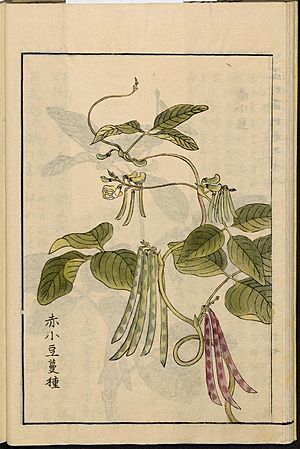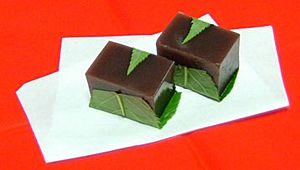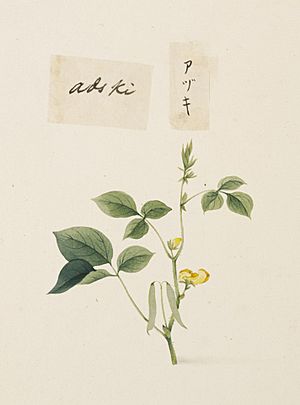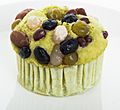Adzuki bean facts for kids
Quick facts for kids Adzuki beans |
|
|---|---|
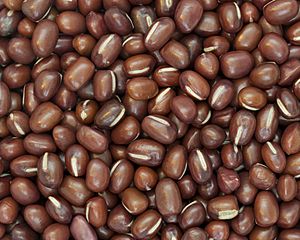 |
|
| Adzuki beans are also called red mung beans. | |
| Scientific classification | |
| Genus: |
Vigna
|
| Species: |
angularis
|
The adzuki bean (also called azuki bean, aduki bean, red bean, or red mung bean) is a small bean that grows on an annual vine. It is widely grown across East Asia. The beans are usually about 5 millimeters long. Most adzuki beans in East Asia are a uniform red color. However, you can also find white, black, gray, and spotted varieties.
Scientists believe that a wild plant called Vigna angularis var. nipponensis is the ancestor of today's adzuki bean.
Contents
Where Adzuki Beans Come From
How Adzuki Beans Became Farmed
The wild plant that adzuki beans came from is likely Vigna angularis var. nipponensis. This plant grows in Japan, Korea, China, Nepal, and Bhutan. The wild adzuki bean and the farmed adzuki bean became different types about 50,000 years ago.
People started growing adzuki beans around 3000 BC. At first, the beans were still quite small, similar to wild ones. But later, during the Bronze Age or Iron Age, when people started using plows, the seeds became larger. When adzuki beans were domesticated, farmers had to choose between getting more beans or bigger beans. Farmed adzuki beans have fewer but longer pods, fewer but larger seeds, and are shorter than wild forms. The total amount of beans they produce is also less than wild forms. We don't know the exact place where adzuki beans were first farmed. It might have happened in several places in East Asia, like Japan, China, and Korea.
Improving Adzuki Beans Through Breeding
In Japan, adzuki beans were one of the first crops that scientists tried to improve. They worked on making the beans produce more, have a purer color, and ripen at the right time. There are also special types of adzuki beans with smaller seeds. These are grown for feeding animals or for use as green manure, which helps make the soil healthier.
Many different types of adzuki beans are grown in China, Japan, Korea, and Taiwan. Japan has over 300 registered types. China and Japan also have large collections of adzuki bean seeds. These collections help scientists study and develop new types of beans.
Wild Adzuki Beans
Wild forms of adzuki beans are often found in Japan. They grow well in places that have been disturbed by humans. Sometimes, old types of farmed beans escape and grow wild. Also, new wild types can grow from mixes of farmed and wild beans.
These wild adzuki beans can be used as a substitute for farmed ones, especially if pests attack the cultivated beans. However, in gardens, these wild beans are seen as weeds. They can mix with the farmed beans and lower the quality of the harvest.
Names for Adzuki Beans
The name adzuki comes from the Japanese name. It can also be spelled azuki. In Japanese, the character for adzuki is also used for shōzu, which means "small bean." The Japanese word for "large bean" is daizu, which refers to soybeans.
In China, adzuki beans are often called hongdou or chidou. Both of these names mean "red bean" because most Chinese types are red. In English, when talking about Chinese food, they are often called "red beans," especially when used in red bean paste. In Korea, adzuki beans are called pat. This name is different from kong, which means "bean" and usually refers to soybeans. In Vietnamese, they are called đậu đỏ, which also means "red bean." In some parts of India, they are called "red chori."
Growing Adzuki Beans
Where and How Much They Grow
Adzuki beans are mostly grown in China (about 670,000 hectares), Japan (60,000 hectares), South Korea (25,000 hectares), and Taiwan (15,000 hectares). They are also grown in the US, South America, India, New Zealand, Kongo, and Angola.
In Japan, adzuki beans are the second most important legume after soybeans. In 1998, Japan produced about 100,000 tons of adzuki beans. Japan also imports a lot of adzuki beans, about 140,000 tons per year. They get them from China, Korea, Colombia, Taiwan, the US, Thailand, and Canada.
The amount of beans grown per area can vary a lot. Some places report 4 to 8 units per hectare, but in Japan and China, farmers can get 20 to 30 units per hectare.
What Adzuki Beans Need to Grow
Adzuki beans grow best when the temperature is between 15°C and 30°C. They don't like frost. The soil temperature needs to be above 6–10°C for the seeds to sprout, with 30–34°C being ideal. Very hot temperatures make the plant grow leaves and stems more, which is not good for producing beans.
Adzuki beans usually don't need extra watering. They grow in areas that get 500–1750 mm of rain each year. The plant can handle some dry weather, but it will produce fewer beans if there's a serious drought. Adzuki beans grow best in well-drained soils with a pH between 5 and 7.5. Farmers use fertilizer, but the amount depends on how many beans they expect to harvest. Adzuki plants can also get nitrogen from the air and put it into the soil, which helps the soil stay healthy.
How Adzuki Beans Are Farmed
Adzuki bean seeds are usually planted 2–3 cm deep in rows. The rows are 30–90 cm apart, and the plants are 10–45 cm apart within the row. Sometimes, seeds are just scattered. The amount of seeds used ranges from 8–70 kg per hectare.
The plants grow slowly at first, so it's very important to control weeds, especially between the time the seeds sprout and when the flowers appear. Farming methods are different in various countries. In China, adzuki beans are often grown with other crops like maize, sorghum, and millet. In Japan, they are grown in crop rotations, meaning different crops are grown in the same field over time. Beans should not be harvested until their moisture content is less than 16%.
Pests and Diseases
Adzuki beans can get sick from fungi and bacteria. Common diseases include powdery mildew, brown stem rot, and bacterial blight. Pests like the adzuki pod worm, Japanese butterbur borer, and cutworm can also attack the plants. The bean weevil is a common pest that attacks the beans after they are harvested and stored.
About the Adzuki Plant
The adzuki bean plant can look a bit different depending on whether it's a wild or farmed type.
The adzuki bean is an annual plant, meaning it lives for one growing season. It is usually a bushy, upright, or climbing plant, growing between 30 and 90 centimeters tall. Some types can climb or spread along the ground. The stem is usually green and has a few hairs.
Roots
Adzuki beans have a main root system called a taproot. This root can grow deep into the soil, up to 40–50 cm from where the seed sprouted.
Leaves
The leaves of the adzuki bean plant have three leaflets, like a clover. They are arranged alternately along the stem on a long stalk. Each leaflet is oval-shaped and about 5–10 cm long and 5–8 cm wide.
Flowers
Adzuki flowers look like butterflies and are bright yellow. The flowers grow in clusters of six to ten (or sometimes two to twenty) flowers in the leaf axils.
Fruits
Adzuki pods are smooth, round, and have thin walls. They are green at first and turn white to gray as they ripen. The pods are between 5–13 cm long and 0.5 cm wide, with 2 to 14 seeds inside each pod. Sometimes, the pods can break open and scatter the seeds during ripening or harvesting.
Seeds
The seeds are smooth and somewhat cylindrical. They are usually 5.0-9.1 mm long, 4.0-6.3 mm wide, and 4.1-6.0 mm thick. A thousand seeds weigh between 50 and 200 grams. Adzuki beans come in many different colors, from dark red to black with straw-colored spots.
How the Plant Grows
When adzuki seeds sprout, the seedling emerges from underground. This takes about 7–20 days. Compared to other beans, the adzuki plant grows slowly. It usually takes 80 to 120 days for the plant to fully grow and ripen, depending on the type of bean and the weather. The plant flowers for 30–40 days. Adzuki plants usually self-pollinate, meaning they pollinate themselves, but cross-pollination (pollination by another plant) can also happen.
How Adzuki Beans Are Used in Cooking
| Nutritional value per 100 g | |
|---|---|
| Energy | 536 kJ (128 kcal) |
|
24.8 g
|
|
| Dietary fiber | 7.3 g |
|
0.1 g
|
|
|
Protein
|
7.5 g
|
| Vitamins | Quantity
%DV†
|
| Thiamine (B1) |
10%
0.12 mg |
| Riboflavin (B2) |
5%
0.06 mg |
| Niacin (B3) |
5%
0.72 mg |
| Pantothenic acid (B5) |
9%
0.43 mg |
| Vitamin B6 |
8%
0.1 mg |
| Folate (B9) |
30%
121 μg |
| Vitamin C |
0%
0 mg |
| Minerals | Quantity
%DV†
|
| Calcium |
3%
28 mg |
| Copper |
15%
0.3 mg |
| Iron |
15%
2 mg |
| Magnesium |
15%
52 mg |
| Manganese |
27%
0.57 mg |
| Phosphorus |
24%
168 mg |
| Potassium |
18%
532 mg |
| Selenium |
2%
1.2 μg |
| Sodium |
1%
8 mg |
| Zinc |
19%
1.8 mg |
| Other constituents | Quantity |
| Water | 66 g |
|
Link to USDA Database entry
|
|
| †Percentages estimated using US recommendations for adults. | |
In East Asian cooking, adzuki beans are often sweetened before eating. They are commonly boiled with sugar to make red bean paste (called anko). This paste is a very common ingredient in many East Asian dishes. Sometimes, other flavors like chestnut are added to the bean paste.
Red bean paste is used in many Chinese dishes. These include tangyuan (sweet dumplings), zongzi (sticky rice dumplings), mooncakes, baozi (steamed buns), and red bean ice. In Japan, it's a filling for sweets like anpan (sweet rolls), dorayaki (pancakes), imagawayaki (waffles), manjū (steamed cakes), monaka (wafers), anmitsu (dessert), taiyaki (fish-shaped cakes), and daifuku (mochi cakes). A thinner version of sweetened adzuki beans is a sweet soup called hong dou tang. Some East Asian cultures also use red bean paste as a filling or topping for waffles, pastries, and biscuits.
Adzuki beans are also eaten sprouted. You can also boil them to make a hot, tea-like drink.
In Japan, rice cooked with adzuki beans (sekihan) is traditionally made for special occasions. Adzuki beans are also used in amanattō (a sweet bean snack) and in ice cream, either whole or as a paste.
Nutritional Information
Cooked adzuki beans are mostly water (66%). They contain 25% carbohydrates, which includes 7% dietary fiber. They also have 8% protein and very little fat.
A 100-gram serving of cooked adzuki beans provides 128 calories. They are a good source of the B vitamin folate (30% of the Daily Value). They also provide several important dietary minerals, ranging from 11% to 27% of the Daily Value.
Gallery
See also
 In Spanish: Azuki para niños
In Spanish: Azuki para niños


